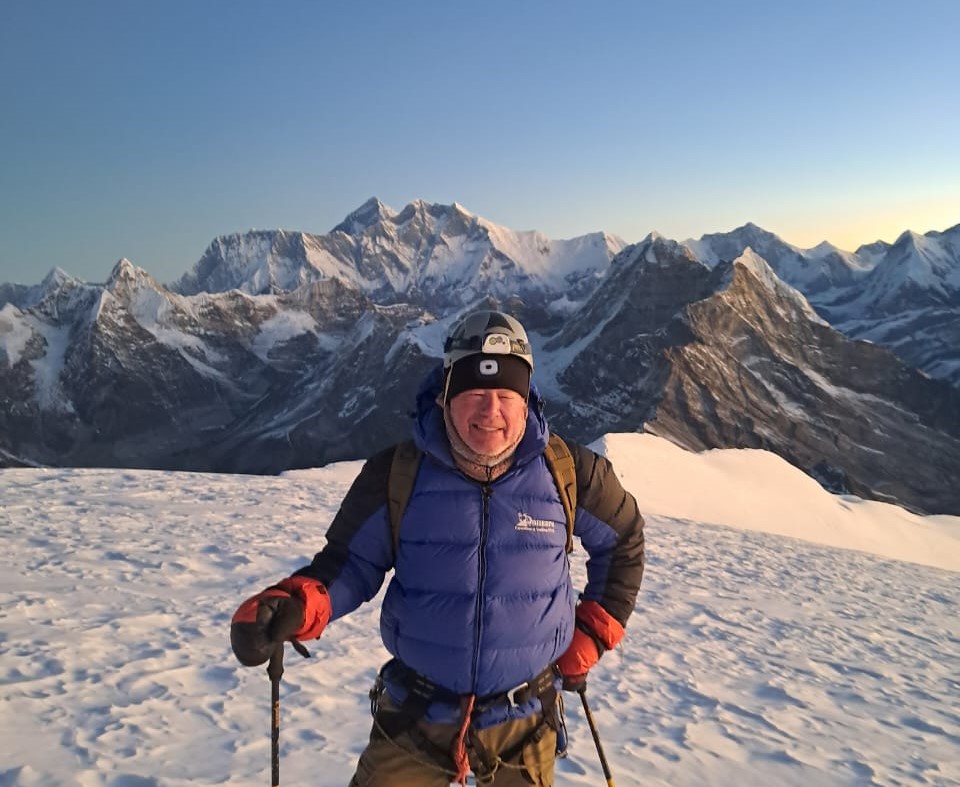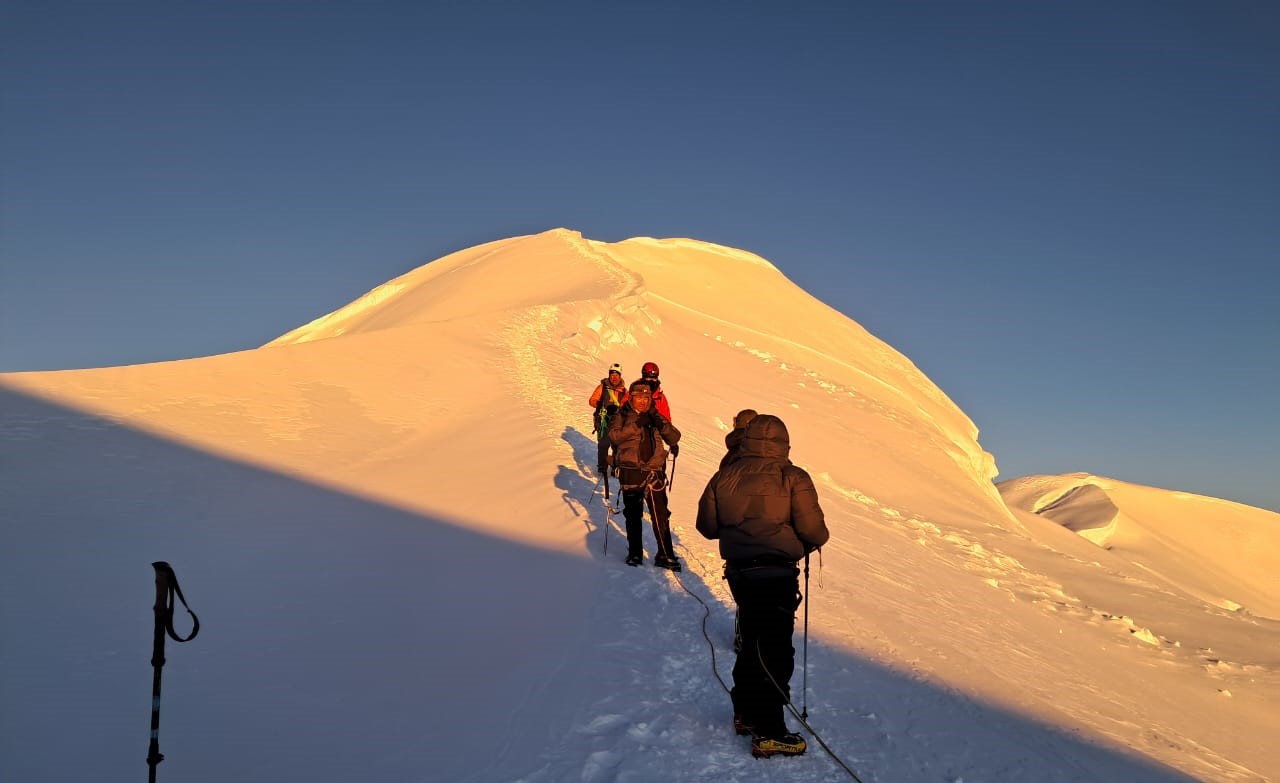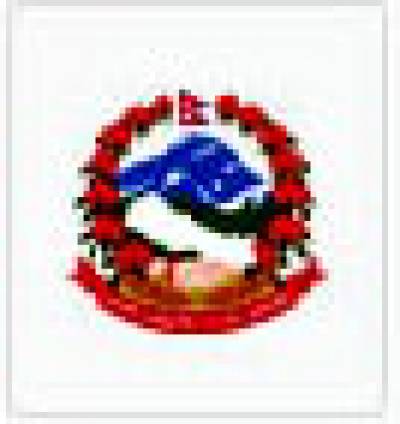MERA PEAK CLIMBING 9 DAYS
Mera Peak Climbing 9-day trek is a fantastic trek in the Himalayan landscape in Nepal with a climb to the Mera Peak and descent back. With its exquisite views, non-technical climbing, Mera Peak is the most popular trekking peak in Nepal. It's an extended itinerary that allows for better acclimatization so that you can enjoy the trek to the summit at 6476 meters.
The adventure starts with a breathtaking flight from Kathmandu to Lukla. On arrival, you will take a short helicopter transfer to Kothe, which will bypass a number of long trekking hours and save both time and effort. You’ll then hike through the jungley woods and alpine meadows of the Hinku Valley, with the Hinku River as your constant companion, as you climb gently upwards to the Khare base camp. You have to take it slow with the gain in altitude, but the beauty is all around you to encourage you to keep going!
What makes the Mera Peak climb different is that it allows trekkers to have input into a high-altitude challenge that’s not as technical as a full mountaineering expedition. You will gently ascend all the way to Mera High Camp through rocky trails, and if you are lucky, on clear days, you will get incredible views of the south face of Mera Peak. Upon reaching High Camp, you will make your summit push. The journey can be overwhelming, but views of the Everest region from high above, including Mount Everest, Lhotse, Makalu, and Cho Oyu, make it worth it.
The summit day is the climax of the trip. In the early morning, you’ll start your ascent to the summit of Mera Peak, and will trek through snowfields, glaciers, and occasionally over steep sections with the aid of ropes. Standing on top is a rush, and you get a 360 view of the mountainous and glacial world around you. There is nothing that can compare to the adrenaline rush you get, standing on top of Mera Peak, having just climbed one of the highest trekking peaks in the world.
Once you summit, you will head back down to Khare and rest up. After a successful summit, you retrace your steps back to Kothe and take a helicopter back to Lukla, from where you will catch a scenic flight back to Kathmandu by air.
This 9-day climb to Mera Peak is ideal for beginners in serious climbing and offers an exciting journey with optimal acclimatization time and breathtaking views of the Himalayas. And it’s a perfect trip for anyone looking for a laid-back, physically demanding, non-technical climbing experience in one of the loveliest mountain ranges on earth.
ITINERARY
Day 1 : Fly from Kathmandu to Lukla (2,800m) & Helicopter to Kothe (3,580m) – Approx. 2 Hours.
Your expedition begins with a breathtaking flight from Kathmandu to Lukla, the famous gateway to the Khumbu region. Upon arrival in Lukla, you’ll switch to a helicopter for a quick flight to Kothe, bypassing lower elevation trails and conserving energy for the ascent ahead. Enjoy stunning aerial views of valleys, ridgelines, and snowy peaks as you soar into the Hinku Valley. After landing in Kothe (3,580m), you’ll settle in at a teahouse and begin acclimatizing to the mountain environment.
Day 2 : Trek from Kothe to Thangnak (4,350m) – Duration: 4–5 Hours.
Your trek officially begins as you ascend through beautiful alpine forests and follow the Hinku River upstream. The trail offers stunning glimpses of snow-covered peaks as you gradually climb to Thangnak, a small settlement used by climbers and yak herders. The landscape becomes increasingly rugged, and you’ll begin to feel the effects of the elevation. Thangnak lies beneath massive cliffs and glaciers, offering spectacular views as you prepare for the days ahead.
Day 3 : Acclimatization Day at Thangnak.
Today is a rest and acclimatization day to help your body adapt to the increasing altitude. You’ll stay in Thangnak and take short hikes to nearby ridges or viewpoints, which are essential for gradual acclimatization. These hikes also offer beautiful views of Charpate Himal and glacial landscapes. This rest is key to preventing altitude sickness and ensuring you’re strong and ready for the climb to higher elevations.
Day 4 : Trek from Thangnak to Khare (5,045m) – Duration: 3 Hours.
After breakfast, you’ll begin your trek toward Khare, the base for Mera Peak. The trail climbs steadily through moraine and rocky terrain, passing by the Dig Glacier and offering panoramic views of Mera Peak itself. Though shorter in distance, the altitude makes the trek more demanding. After about three hours, you’ll arrive in Khare, a small village nestled at the foot of the mountain, where you’ll rest and prepare for the summit.
Day 5 : Acclimatization Day at Khare.
Another essential acclimatization day is spent in Khare. Your guide will conduct a pre-climb training session, where you’ll learn how to use gear like crampons, harnesses, ropes, and ice axes. This practice boosts your confidence and ensures safety during the summit push. Light hiking and hydration are encouraged as your body adjusts to over 5,000 meters of altitude.
Day 6 : Trek to Mera High Camp (5,700m) – Duration: 4–6 Hours.
Today’s climb to Mera High Camp is a significant step toward your summit. The route includes crossing Mera La Pass, moving through glacial terrain, and ascending rocky trails. The views get more dramatic, with Everest, Makalu, and Baruntse visible in the distance. At High Camp, you’ll stay in tents and rest early in preparation for the early morning summit attempt. The camp offers an unforgettable view of the starry sky over the Himalayas.
Day 7 : Summit Mera Peak (6,476m) & Return to Khare – Duration: 8–9 Hours.
Summit day begins before dawn, typically around 2 AM. Equipped with headlamps, crampons, and ropes, you’ll climb slowly across the glacier toward the summit of Mera Peak, the highest trekking peak in Nepal. After 6–7 hours of effort, you’ll reach the summit (6,476m), where a 360-degree panorama includes Everest, Lhotse, Makalu, Cho Oyu, and Kanchenjunga. After celebrating and taking photos, you’ll carefully descend back to Khare, arriving in the late afternoon for well-deserved rest.
Day 8 : Trek to Kothe (3,580m) – Duration: 4–5 Hours.
After breakfast, you’ll begin your descent from Khare to Kothe, retracing the trail through glacial valleys and alpine meadows. The downhill route is easier on the lungs but requires good balance and care on rocky paths. You’ll return to lower altitudes, which helps your body recover. Enjoy the relaxed pace and warmer air as you settle in for the night in Kothe.
Day 9 : Helicopter to Lukla & Flight to Kathmandu – Duration: 6–7 Hours.
Your return begins with a scenic helicopter flight from Kothe to Lukla, saving time and energy after your climb. From Lukla, you’ll board a domestic flight back to Kathmandu, where the journey concludes. Upon arrival, you’ll transfer to your hotel and enjoy the comforts of the city while reflecting on your incredible Himalayan experience.
SERVICES
Costs Included in Your Package
- Domestic Airport Pick-Up and Drop-Off: Private car or jeep transfer from/to the airport for your convenience and comfort.
- Meals During the Trek: Three nutritious meals per day (breakfast, lunch, and dinner), including fresh fruit served each evening after dinner.
- Scenic Helicopter Transfer: Shared helicopter flight from Lukla to Kothe -Lukla, offering a spectacular aerial view of the Himalayas.
- Accommodation: Comfortable trekking lodge (tea house) stays during the trek, and tented camp accommodation during the Mera Peak climbing session.
- Permits and Entry Fees: All necessary paperwork, including the Makalu National Park Entry Permit fees.
- Flights and Transfers: Round-trip domestic flights (Kathmandu–Lukla–Kathmandu via Ramechhap) with private airport transfers and applicable airport taxes.
- Experienced Trekking and Climbing Guide: An English-speaking, government-licensed guide who is friendly, knowledgeable, well-trained, and fully insured—covering all his expenses, including salary, food, accommodation, transport, and insurance.
- Mera Peak Climbing Permit: Official permit for climbing Mera Peak.
- Sherpa Porters: Reliable, helpful Sherpa porters (one for every two trekkers) equipped with proper safety and walking gear. Their salary, meals, accommodation, and insurance are covered.
- Medical Support: A Comprehensive first aid kit is available throughout the trek for your safety and peace of mind.
- Emergency Helicopter Arrangement: Coordination of emergency helicopter evacuation (covered by your personal travel insurance, if required).
- Essential Trekking Gear (On Loan): Complimentary use of sleeping bag, down jacket, duffel bag, and walking poles (to be returned after the trek).
- Exclusive Souvenirs: Sherpa Expedition & Trekking T-shirt and a trip achievement certificate upon successful trip completion.
- Health Monitoring: Daily use of an oxygen meter to monitor your pulse, oxygen saturation, and heart rate—crucial for detecting early signs of Altitude Mountain Sickness (AMS).
- Assistant Guide: An additional assistant guide will be provided for groups of 8 or more trekkers to ensure safety and personalized attention.
- Government Fees and Taxes: All government taxes and official expenses are included.
Costs Excluded from Your Package
- Meals in Kathmandu: Lunch and dinner while staying in Kathmandu are not included.
- Hotel Accommodation in Kathmandu: Accommodation in Kathmandu before or after the trek is not covered.
- Nepal Entry Visa: The Nepal visa fee is not included. Visas are available on arrival at Tribhuvan International Airport:
- $30 USD for 15 days
- $50 USD for 30 days
- $125 USD for 90 days
- Travel & Medical Insurance: Personal travel and medical insurance (mandatory for trekking and climbing).
- International Airfare: Flights to and from Nepal are not included.
- Personal Expenses: Any personal spending such as souvenirs, laundry, and snacks.
- Drinks & Snacks During the Trek: Alcoholic and non-alcoholic beverages (including tea, coffee, soup, hot chocolate, cocoa, bottled water), as well as any extra food items purchased along the way or at tea houses (e.g., additional meals, snacks, desserts like chocolate, cake, pudding, etc.).
- Extras at Tea Houses: Charges for hot showers, Wi-Fi, and battery charging at trekking lodges are not included.
- Tips: Gratuities for guides, porters, and drivers (tipping is customary and appreciated).
- Excess Baggage Fees: Extra baggage over 10 kg on the Lukla flight may incur additional fees.
- Early Return from Trek: In case of an early return due to illness or any unforeseen reason, the cost of unused services (flights, accommodations, meals, etc.) is non-refundable. Any additional expenses in Kathmandu (hotel, meals, etc.) will be your responsibility.
EQUIPMENTS
You’ll carry your personal gear and share some group equipment, so pack light with layered, weather-appropriate clothing—avoid cotton and choose breathable, insulating fabrics. A windproof duffle (provided and carried by porters) and water are included. Non-trekking items can be stored in Kathmandu. Sherpa Expedition & Trekking supplies all essential expedition gear.
Upper Body:
- Base Layers: Moisture-wicking and quick-drying shirts and thermal tops.
- Insulation Layers: Fleece or down jackets to provide warmth.
- Waterproof Shell Jacket: A durable and breathable jacket to protect against wind and rain.
- Softshell Jacket: A lightweight and water-resistant jacket for added protection.
- Climbing Harness: A comfortable harness to secure yourself to the rope.
- Helmet: A strong and well-fitting helmet to protect your head from falling objects.
- Gloves: A combination of lightweight liner gloves and insulated gloves or mittens for warmth and dexterity.
- Buff or Neck Gaiter: To protect your neck and face from cold and wind.
- Sunglasses: Polarized and UV-protected sunglasses to shield your eyes from the sun and snow glare.
- Goggles: Ski or mountaineering goggles for added eye protection in extreme weather conditions.
Lower Body:
- Base Layers: Moisture-wicking and quick-drying thermal bottoms.
- Insulation Layers: Fleece or insulated pants for added warmth.
- Waterproof Shell Pants: Durable and breathable pants to protect against wind, rain, and snow.
- Softshell Pants: Lightweight and water-resistant pants for added protection.
- Mountaineering Boots: Sturdy and insulated boots designed for snow and ice.
- Crampons: Attachable spikes that provide traction on icy terrain.
- Gaiters: Waterproof and breathable gaiters to keep snow out of your boots.
- Socks: A combination of moisture-wicking liner socks and thick, warm mountaineering socks.
Other Essential Items:
- Backpack: A spacious and sturdy backpack to carry your climbing gear and personal belongings.
- Sleeping Bag: A warm and lightweight sleeping bag that can withstand sub-zero temperatures.
- Trekking Poles: Adjustable trekking poles for added stability and support.
- Headlamp: Essential for climbing in low-light or dark conditions.
- Water Bottles: Insulated water bottles to keep your water from freezing.
- Sunscreen: High SPF sunscreen to protect your skin from the strong sun at high altitudes.
- First Aid Kit: A comprehensive first aid kit with essential medications and supplies.
- Climbing Snacks: Energy bars, nuts, and other lightweight snacks for quick fuel during the climb.
It is important to invest in high-quality gear and ensure that everything fits properly and is in good condition. Additionally, consult with experienced climbers or a professional guide to ensure you have all the necessary gear and receive proper training on how to use it effectively and safely.
Note: Essential climbing equipment, including an ice axe, crampons, climbing boots, harness, helmet, safety rope, ascender (jumar), and carabiner, can be hired in Khare. The total cost is approximately USD 120 per person for a complete set.
GOOD TO KNOW
⛰️ Altitude Acclimatization is Essential
Mera Peak reaches a towering height of 6,476 meters, where oxygen levels drop significantly. The 9-day itinerary includes proper acclimatization periods, allowing your body to gradually adjust to higher elevations. Spending extra nights at Khare and climbing slowly reduces the risk of altitude sickness and improves your chances of a successful and safe summit. Stay hydrated, avoid alcohol, and listen to your guide's advice to adapt comfortably.
🧗 Climbing Skills Are Helpful But Not Mandatory
Mera Peak is classified as a trekking peak, which means it doesn’t require advanced mountaineering skills. However, some basic climbing knowledge is useful. The summit involves walking on snow and ice, and you’ll use crampons, an ice axe, and harnesses. Your guide will provide training at Khare, so even beginners can attempt the climb safely and confidently under professional supervision.
🚁 Helicopter Access Enhances Comfort
One of the biggest advantages of this itinerary is the helicopter transfer between Lukla and Kothe. It shortens long trekking days and saves energy for the actual climb. The return helicopter flight also adds convenience, especially if weather conditions in the mountains are unpredictable. These transfers are scenic and efficient, offering a bird ''s-eye view of the Himalayas.
🥶 Weather Can Be Harsh Above 5,000m
Expect freezing temperatures, especially during early morning summit pushes. Weather in the Himalayas can change rapidly, with strong winds, snowfall, or sudden drops in temperature. It's crucial to pack proper high-altitude clothing, including thermal layers, windproof jackets, insulated gloves, and mountaineering boots to stay warm and safe at higher elevations.
🛂 Permits Are Required and Included
To climb Mera Peak, you’ll need a set of official permits:
Mera Peak Climbing Permit
Makalu Barun National Park Entry Permit
TIMS (Trekkers’ Information Management System) Card
These are generally managed by your trekking agency and included in the trip cost. Always carry a photocopy of your passport and extra passport photos for documentation purposes.
🧳 Pack Smart for High Altitude and Camping
While some gear, like ropes and tents, are provided, you’ll still need personal trekking and climbing essentials. Pack light but efficiently:
Warm layers
Sunglasses & sunscreen
Personal medications
Lightweight sleeping bag (rated for -20°C or below)
Be prepared to carry your daypack daily, while porters handle the heavier loads.
🍲 Food and Lodging Vary by Altitude
Throughout the trek, you’ll stay in teahouses that offer simple yet hearty meals like dal bhat, pasta, rice, and soups. As you ascend, food variety becomes limited, especially at Mera High Camp, where meals are basic and cooked in a camp kitchen. It’s wise to bring a few energy bars or snacks for the trail.
💉 Travel Insurance is Mandatory
Due to the remote location and high altitude, having comprehensive travel insurance is not just recommended—it’s required. Your policy must cover:
High-altitude trekking (up to 6,500m)
Emergency helicopter evacuation
Accident and illness abroad
Make sure your provider confirms all coverage in writing before departure.
🧍♂️ Small Group Size Means Personalized Support
Most Mera Peak expeditions are run in small groups of 2–10 trekkers, ensuring personalized attention from guides and better team coordination. Small groups are safer at high altitudes and offer a more intimate, supportive trekking experience.
📆 Best Time to Climb: Spring or Autumn
The best seasons to climb Mera Peak are pre-monsoon (March to May) and post-monsoon (September to November). During these months, you’ll get clear skies, stable weather, and the best chances of a successful summit. Avoid winter and monsoon seasons, as harsh weather can make the climb more dangerous.
MAP
PHOTOS/Videos
Departures
Select a departure month
Fill out the form below and a Travel Expert will reach out to create your perfect tour.
FAQS
How difficult is the Mera Peak climb?
Mera Peak is a moderately difficult trekking peak. While it's not technically demanding, the high altitude, cold weather, and long summit day make it physically challenging. Good fitness and mental endurance are essential.
Do I need mountaineering experience to climb Mera Peak?
No prior mountaineering experience is required, but basic knowledge of using crampons, ice axe, and harnesses is helpful. Your guide will provide training and practice at Khare before the summit attempt.
What’s the best time to climb Mera Peak?
The best times are spring (March–May) and autumn (September–November). These seasons offer clear skies, stable weather, and the safest conditions for high-altitude climbing.
Where do we sleep during the trek?
You'll stay in teahouses during the trek, which offer basic accommodation. At Mera High Camp, you’ll sleep in tented camps, equipped for cold weather and high-altitude camping.
What happens if I get altitude sickness?
Your guide monitors for symptoms daily. If signs of Acute Mountain Sickness (AMS) appear, you may descend or receive emergency helicopter evacuation if needed. Acclimatization days are built into the itinerary to minimize risk.
What permits are required for Mera Peak?
You’ll need:
Mera Peak Climbing Permit
Makalu Barun National Park Permit
TIMS Card
These are generally included in the trekking package and arranged by your tour operator.
What gear do I need to bring?
Bring high-quality warm layers, mountaineering boots, gloves, sunglasses, headlamp, and a sleeping bag rated for -20°C. Technical gear like ropes and crampons are often provided by the operator.
What kind of food is available during the trek?
Teahouses serve hot meals like dal bhat, noodles, pasta, soups, and eggs. At High Camp, food is simple and energy-rich. It’s smart to bring snacks and energy bars for extra fuel.
Why is helicopter transfer used?
The itinerary includes helicopter flights to and from Kothe to save time, reduce physical strain, and improve acclimatization. It also provides a more efficient and scenic journey through remote terrain.
Is travel insurance necessary?
Yes, travel insurance is mandatory. It must cover high-altitude trekking (up to 6,500m), medical emergencies, and helicopter evacuation. Without it, you may not be allowed to join the climb.
Latest Traveller’s Reviews
Travel experiences of our clients who recently returned from their trips.
100%
Based On 896 Reviews
Reena Kuhrram
United States
September 17, 2024
Wonderful Experience from Start to Finish
I had a wonderful experience trekking to Everest Base Camp with Sherpa Expedition and Teams. The level of professionalism and care was evident from the start. Our guides were excellent at facilitating our acclimatization and ensuring everyone was in good spirits. The breathtaking landscapes and the warm hospitality in the teahouses made the trek unforgettable. I felt a true sense of camaraderie with fellow trekkers, all thanks to the fantastic atmosphere the Sherpa team created.
Daniella Garcia
Austria
September 2, 2024
Unforgettable Journey
My trek to Everest Base Camp with Sherpa Expedition Teams was nothing short of magical. The guides were incredibly knowledgeable and attentive, ensuring our safety and comfort throughout the journey. The breathtaking views, especially of Khumbu Glacier, left me in awe. Every meal was delicious, and the teahouses were cozy. I felt genuinely supported every step of the way. I highly recommend Sherpa Expedition for anyone seeking an adventure of a lifetime!
Laurence Fang
United States
August 29, 2024
Epic Adventure!
Trekking with Sherpa Expedition and Teams was an epic adventure. Their expertise in organizing the trek was apparent, and our guide was a wealth of knowledge. The trek itself was challenging yet thrilling, with stunning views that took my breath away. I felt safe and supported throughout, and the local culture added an enriching layer to the experience. Reaching Everest Base Camp was a dream realized. I wholeheartedly recommend this team for anyone looking for an incredible trek!
People Considering This Package Right Now Check availability
























